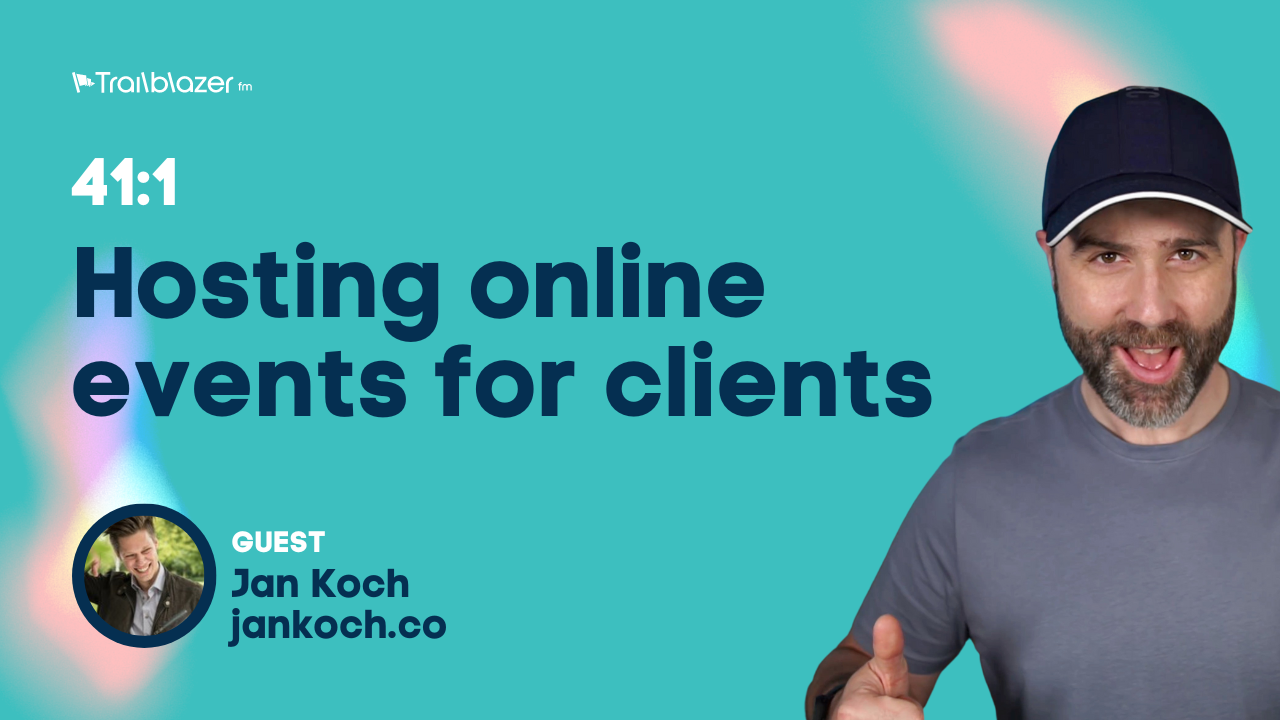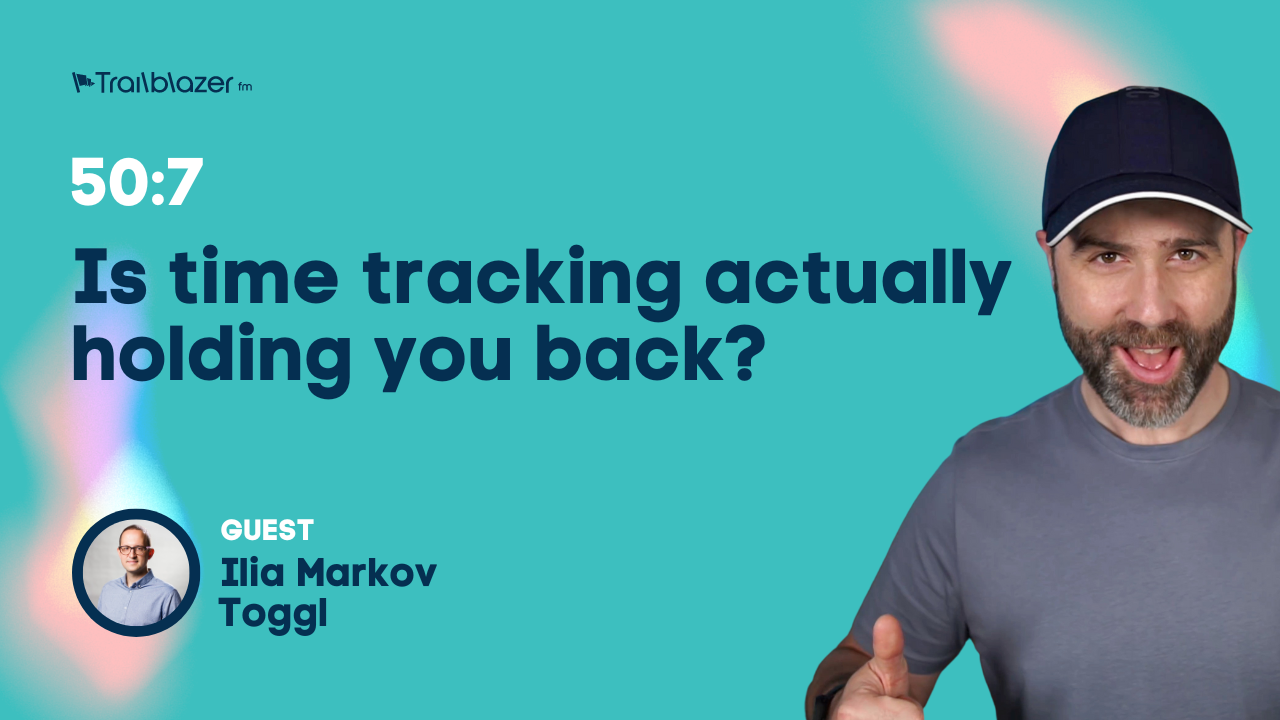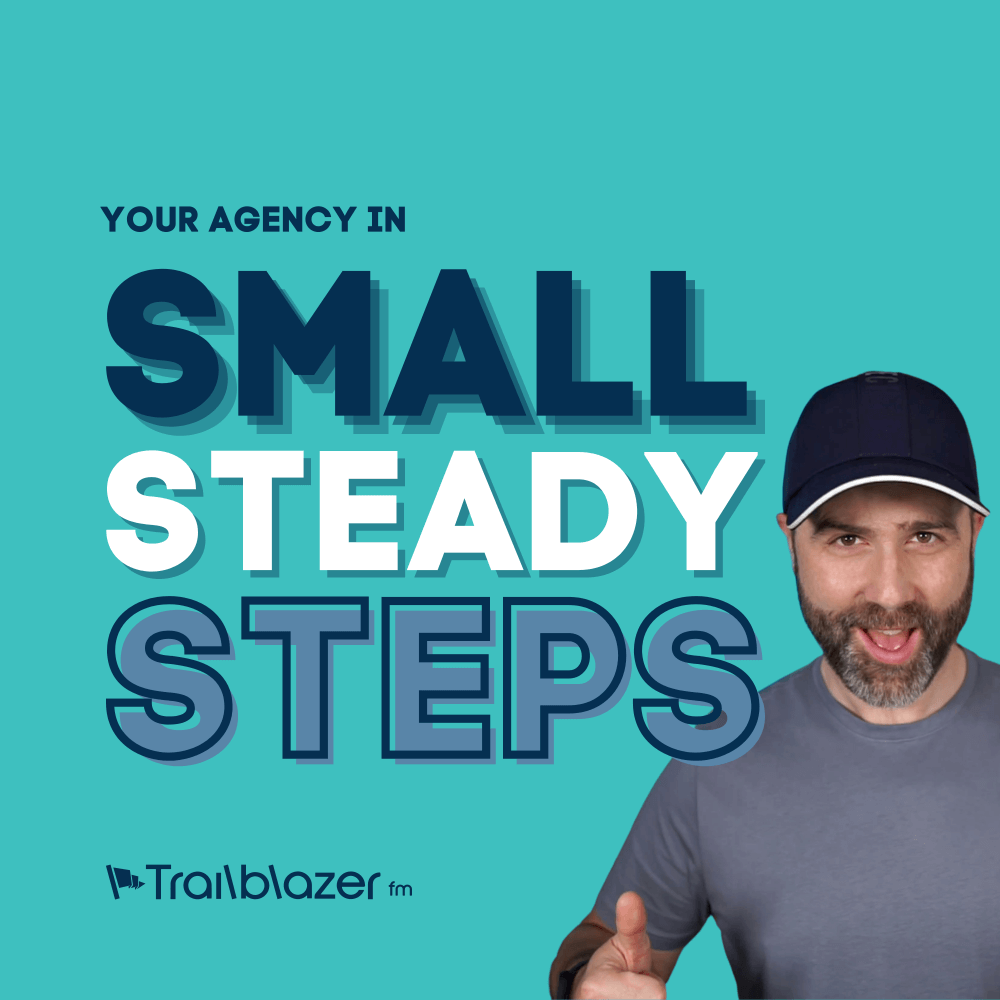
41:1 Hosting online events for clients
Hosting a virtual summit for your client is an excellent way to help your client generate leads and build authority. This week, Jan Koch is our guest host as he shares five common mistakes agencies make when hosting summits for their clients.
Hosting a virtual summit for your client is an excellent way to help your client generate leads and build authority. This week, Jan Koch is our guest host as he shares five common mistakes agencies make when hosting summits for their clients. To learn more about summits, get guidance on coming up and validating your profitable summit idea, and understand all processes involved in hosting a summit, sign up for Jan’s free workshops (running live every month) at trailblazer.fm/vsmworkshop

Too busy to take notes? Jan has you covered. Here are the five key mistakes along with key questions or takeaways.
Not defining a persona for the attendees
- you need to know who should attend
- why would somebody attend? What problem is the summit solving for them?
- what’s keeping them awake at night?
- what transformation can a summit deliver that the current offering of your client cannot?
- what sets your summit apart from other events in the spac?
Onboarding speakers that don’t or cannot promote
- Speakers sharing your event is the most important strategy to drive traffic to any summit
- The summit host gets authority when expert speakers introduce the event to their audience
- Promotion compounds when many speakers share the event at the same time
- You can truly dominate the news in your industry if you do this correctly
- If your speakers don’t share the event, you end up paying big money for leads via ad campaigns
- When helping your client chose speakers, ensure that the speakers will promote the event to their audience
- Create swipe copy and graphics to make promotion easy
Not creating a playbook for the virtual summit
- For pre-recorded summits, pull out one or two lessons from each sessions and put them into a playbook
- Professionally design this PDF to fit the summit brand
- This adds authority to the summit host
- Use the playbook on a dedicated landing page to test it against the main registration page
- Use the playbook in retargeting campaigns that target people who didn’t register
Not having a funnel in place
- All-Access Pass sales are a great source of income but you’ll leave money on the table without upsells
- Add at least one or two upsells and a downsell to the funnel
- These can be memberships, books, affiliate products, existing offers your client already has
Not repurposing the summit contents after the event ended
- Your client is sitting on hours of video content, don’t waste this
- Break down each summit session into multiple blog posts
- Cut each session into short 1-minute videos and promote them on social
- Transcribe those short videos and share them in written posts
- Repurpose the sessions for podcasts
- Transcribe all sessions and format them as a book – your client now has an audience to launch it to
Remember: To learn more about summits, get guidance on coming up and validating your profitable summit idea, and understand all processes involved in hosting a summit, sign up for Jan’s free workshops (running live every month).
Transcript
Welcome, everybody, to this episode of the Agency Trailblazer podcast. First of all, a big thank you to Lee for making me the co-host of this episode. I’m really honoured by this and I wanted to talk about five common mistakes that digital agencies make when they are hosting online events or virtual summits for their clients.
So these mistakes can absolutely ruin a virtual event, which is obviously something you want to avoid when you are organising an event on behalf of your customers, because those events can deliver so much value for your customers. It’s literally one of the best marketing methods I’ve seen over the past. I want to say decade, even in the digital marketing space and all the five lessons that you’re about to hear are lessons that I’ve made myself, mostly in the first summit, so that starting in 2015 and I was just testing and I wasn’t as experienced as I am now.
I’ve made most of those mistakes, I see countless people who are not following the VSM Process make these mistakes, and honestly, it breaks my heart because those summits, they are a lot of work if you don’t have the right processes in place.
So with this podcast episode, my goal is to help you organise better events for your customers or maybe even to start to help you get on this path of organising virtual events, because Lee’s in the events industry, he does amazing things with Event Engine. I love the actual events of organising the summits and I see day in and day out what results they can bring for the summit hosts. So let’s dive right into this.
Mistake number one is; not defining a clear persona for the attendees and why this might be something that you take for granted. You would be surprised how deep you can go with defining your virtual attendee persona. So this is somewhat similar to defining a customer avatar, defining a client, and usually when you’re working with somebody, when you’re working with a business owner, they have that persona. But from my experience, sometimes those personas aren’t defined well enough.
So you need to know very, very clearly who should attend the virtual summit. Who is it that you want to have at your virtual summit and why would they come to your event? What is it that makes the event you are organising stand out against the events that are already in the space? What problem is your summit solving for them that other events cannot? What’s keeping those people who attend the summit awake at night? What is it that they secretly wish was true about them but it isn’t?
What is that transformation? You know, this one thing that urges them, that gets them out of bed in the morning. What is that transformation that your summit can deliver that maybe even the current offering of your client cannot? What is it that after attending the summit that you are organising, your attendees will remember about the event? What how do you make them feel when they are attending the summit?
These are all very important things and I think they go a little bit deeper than just defining who’s buying your customer’s offerings. This is really about building a community with your event. You need to be very specific about who your event is for. For example, you shouldn’t hold something like the “business summit”, “fitness summit” or the “health summit”, but on the other hand, you could do something like the “woman strength summit”. You could do something like the Virtual Harp Summit, which did amazingly well with, I think, 50000 attendees over time for Diana Rowan.
You could do something like “list building school” for people who want to build a bigger email list for digital marketers, online course creators, instead of doing an online marketing summit, for example. One of the mistakes that I’ve made in the past with this very specific example is I’ve run the WP summit in 2015 as my first ever event. Well, who is the summit for? Is it for WordPress developers? Is it for common people who use WordPress who don’t know how to write code, is it for WordPress agencies? Is it for plug in creators? Is it for theme creators? I wasn’t specific enough with this event and still I had over 5000 attendees and I made five figures in revenue, so I can only imagine how much money I left on the table by having this really, really vague persona for the attendees.
Now, mistake number two is onboarding speakers that don’t promote or that cannot promote because they don’t have a big list or their list isn’t exactly relevant to your target audience.
Let me get one thing clear here. Speakers sharing your event is the most important strategy to drive traffic to any summit, whether it’s the summits that you are organising, whether it’s a summit that I am organising, whether it’s summits that VSM students are organising, they all rely on promoting by the speakers. The summit host gets authority when the speakers introduce the event to the audience. That’s the biggest thing. If a thought leader and an influencer introduces you to their audience and says something like, hey, did you see that Lee Jackson put this amazing virtual conference together? It’s called Agency Transformation Life. And he wanted to do it in person, but due to the situation, he had to do it online. And he did an amazing job. And I think you should attend.
What does it do to Lee’s brand? It is immediately boosting his authority in your eyes because the recommendation is coming from somebody you already know, like and trust. So if you help your customer choose speakers who they want to have speaking at the virtual summit, ensure that those people can promote and will promote, at least via social media. It’s tougher to get those big names to promote via email, but they should at least promote via social media. That’s a really important step because that promotion compounds when many speakers share the event at the same time.
That is why you have a mix of speakers. You don’t have just high profile like John Lee Dumas, Tony Robbins, Mel Robbins, Vishen Lakhiani from Mindvalley, Ryan Holiday. You don’t have only speakers on that level. You have like two or three high profile speakers who are really well known in your industry.
But then you taper down. You have a few trusted authorities who have a decent audience, and you have around 60 percent of speakers who are up and comers. They really know their stuff, but that they don’t have a big brand yet. And those up and comers will share the heck out of the virtual summit because they get to share the stage with these amazing high profile entrepreneurs, high profile thought leaders with those amazing, amazing experts. And they would promote and if you get those big experts, those big names to share on social and then the trusted authorities and the up and comers promote via email and social, you build up quite an audience.
And as a ninja trick, you should also get media partners involved. Get the media outlets in your space involved to feature your virtual summit. Maybe they can do an interview with you. Maybe they can feature the summit as a case study. Maybe they can include it in the weekly newsletter or something like that. Reach out to the media platforms, to any platform that is relevant for your target audience to get them to share your virtual summit. And the one thing that you can do to make this promotion as easy as possible for your speakers is to create swipe, copy and promotional graphics.
This is a task that cannot be overstated, how important it is. You need to have high quality swipe copy and professionally designed promotional graphics so that your speakers are enabled possible to promote and also give them a very clear promotional calendar so that they know when to promote and can fit it into their existing marketing schedule.
Now, mistake number three is something that might not be as well known, but it’s still a very common mistake and that is not creating a playbook for a virtual summit.
Now, what does a playbook? A playbook is essentially a lead, making it a freebie bonus offer, if you will, that you give to attendees when they sign up for the free ticket to the summit. And a playbook usually consists of one or two lessons that are shared from each speaker that you can easily pull out. And you do in a pre-recorded summit for your customer, You are sitting on all those recordings. Have your customer at the end of each interview ask the speaker what is their one best tip they would give to somebody who’s attending their session to get the desired outcome that the session was focussed on.
So, for example, I am working on an email marketing summit right now, the “List Building School”. After every interview I ask my speakers, what is your best strategy to build a targeted email list? And then that’s usually one minute to two minute answer from the speaker. And I know exactly that, that’s at the end of each session, so I don’t even have to search for it when I’m post-processing. I pull out those lessons, those tips shared, and I put them into a playbook that’s a professionally designed PDF that fits the summit brand and that adds massive authority to the summit itself and to me as a summit host, because I’m putting together this playbook and then I can use this playbook on a dedicated landing page to test it against the main registration page.
So you always want to be testing when you’re hosting virtual summits. And I’m not telling you anything new that the testing is important when you’re doing launch campaigns. But with that playbook, you have a different hook for people to sign up. It’s not just that they get the free sessions, it’s also that they get something they can implement straight away. So set up a dedicated landing page, test, a playbook against the main registration page. Some students in “Virtual Summit Mastery” said that the playbook converts better, but the conversion rate on the all access pass wasn’t as high. So maybe depending on your market, you might attract “freebie seekers”. So that is something that you have to keep in mind and you have to pay very close attention to your numbers. But again, if you have done the digital launch before, you know that checking your numbers is really important, and I’m not telling you anything new.
And most importantly, use that playbook in retargeting campaigns so that you get those people who didn’t register on the first visit to eventually still grab their free ticket for your virtual event.
Mistake number four is not having a funnel in place. And this is also something that we as digital marketers understand very well, and we know about the, the power of having a really good sales funnel in place. But the thing with virtual events is that your customer likely doesn’t understand that. So he needs to be educated about having a virtual summit funnel because what they may think is, well, you keep the summit for free so that people can attend it live while it’s free, that is really, really important, because if you charge for the summit just because being promoted as much and it won’t get so much organic coverage in media outlets, whereas when it’s free, everybody loves free stuff, everybody loves free events and people are happy to speak about this.
So you have to sell the replays in what’s called an “all-access pass”. And those are all-access pass sales are a fantastic source of income, but you leave money on the table if you don’t have up-sells for that all access pass. Usually what we teach in “Virtual Summit Mastery” is that immediately after somebody signs up, you take them to a confirmation page that confirms that they’ve got the free ticket and that also gives them a one time offer on the all-access pass for a discounted price that lasts for like anything from 15 minutes to an hour, so that you reward fast action takers when they upgrade to the all-access pass, straight after signing up, they get maybe 50 percent off from the original price.
That is not a funnel though. The funnel comes into place when after somebody buys the all-access pass, they get presented with a second offer and maybe a third. Those could be memberships, those could be books. It could be existing offers the clients already has and sells. It could be even affiliate products work really, really well. I’ve seen many virtual summit hosts, pitch high ticket affiliate offers at the back of the summit funnel and make really, really good money with this.
So even somebody selling a 5K affiliate product can add another 20 or 30 K in revenue to the virtual summit, and he doesn’t even have to have his own product that he’s selling. So build a funnel when somebody buys the all-access pass. Think about what offers would complement that and would take the usability of the all-access pass to the next level, make it an even better purchase for your customers. And then also, if somebody doesn’t like the all-access pass, maybe just present them with a down-sell. So, for example, in the all-access pass, I usually include video recordings and audio recordings, worksheets, extra notes and all the good stuff.
Basically, I repurpose the sessions in various formats so that people can digest them in the way they prefer. The down-sell would be just having the video recordings and the audio recordings. They don’t get worksheets, they don’t get checklists, they don’t get all the other bonuses. But maybe the audio and video recordings are good enough for them to buy a down-sell at a discounted price.
And mistake number five, the last one I want to cover in this episode is not repurposing the summit contents after the summit ended. And that’s a big one. I see way too often, myself included, have made this mistake way too often before. And it took me a couple of months to figure out a good process to have this in place. Essentially, your client is sitting on tons of hours of video content after the event ended. Don’t waste this like I did with three of my virtual summits that I didn’t repurpose at all.
You are sitting on say you have 20 sessions and each 45 to 60 minutes. So that is at least 15 hours of video content. You can break down each summit session into multiple blog posts, for example. So each session, if it’s 45 minutes, you can easily extract five blog posts out of this. Usually you would have like five minutes of video turned into a thousand words. So those are five three thousand word blog posts. You can also cut each session into short one minute videos, pull out just the highlights from the session and then share them on social.
Put a dollar a day against them on Facebook, on Twitter, on Instagram, TikTok, wherever your customer is present and needs to build an audience and just boost those short one minute videos so that you can build up an audience that you can retarget against in the future with your seriously generation of us and sales offers. You can also transcribe those short videos, share them as written posts. You can also do audiograms from that. So one short minute short one minute video can essentially be a transcription. It can be an audiogram. So you have three social post at least, and then you can obviously break that down into multiple tweets. So you have around five to ten social media content pieces from a one minute video.
You can also repurpose all those sessions for a podcast. Maybe you can bring a part of the session into a podcast and then invite the guest back even to continue the conversation that you started in the summer session on a podcast episode and another fantastic way to repurpose the summit content, and that’s what I want to end this episode with, is; transcribe all the sessions and package them into a book because a customer now has the audience to launch it to. Just put all the sessions, format them as a book and set up a proper launch campaign for the book so that your customer can now maybe even potentially launch a bestseller on Amazon because they now have the audience to launch it to.
Now, those are just five mistakes that I’ve seen over and over again in my career of hosting virtual summits, I’ve been doing this since 2015 and I’m working on a workshop series you can actually go to, trailblazer.fm/vsmworkshop and sign up. They are starting on August 16th. You can catch the replays, of course they are free. Everything you need to know is on that website.
If you want to learn more about hosting those virtual summits, these workshops take you from coming up with a profitable virtual summit idea via actually validating your ideas. During those workshops, I teach you how to get an “influencer action plan” together so that you can connect with influencers even if you or your customer has no real audience online.
Then we talk about the summit platform and the fourth workshop is a masterclass where we pull everything together. So that’s trailblazer.fm/vsmworkshop.
Again, a big thank you to Lee Jackson for letting me co-host this episode. I’m truly honoured. I appreciate you as a friend Lee, and keep up the fantastic work.








